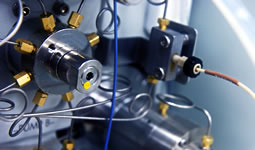Recent News & Events
High Performance Liquid Chromatography (HPLC) - How Does it Work?
26
 High Performance Liquid Chromatography (HPLC) is a widely used analytical technique that many industries and research fields rely heavily on. In this article you will learn how HPLC systems work and the different types of HPLC machines that are commonly used. This article is the first in our series about HPLC’s and its purpose is to give you a general overview of HPLC systems.
High Performance Liquid Chromatography (HPLC) is a widely used analytical technique that many industries and research fields rely heavily on. In this article you will learn how HPLC systems work and the different types of HPLC machines that are commonly used. This article is the first in our series about HPLC’s and its purpose is to give you a general overview of HPLC systems.
If you are looking for more in depth information, don’t worry, there will be more articles in the near future starting with our next article which will cover HPLC equipment and techniques for chemical applications, followed by our article on HPLC equipment and techniques for biological/life science applications.
How Does HPLC Work?
HPLC is used to quantify, identify and isolate the components of non-volatile liquid mixtures (volatile compounds are separated by GC- Gas Chromatography). Solvent is pumped from a solvent reservoir and mixed with the liquid sample. The solvent sample mixture passes through a HPLC column and into a detector, where an electronic output is given as a chromatograph. The waste collects in a vessel outside of the machine.
The HPLC column is the separation component of the system. HPLC columns contain “packing material” with various pore sizes, which is known as the ‘stationary phase’. The liquid sample that passes through the pores is known as the ‘mobile phase’. As the mobile phase passes through the stationary phase, the larger molecules become trapped by the smaller pores, allowing the smaller molecules to elute faster - This is the isolation and separation process. This causes the smaller molecules to have a quicker retention time and larger molecules to have slower retention times. The retention (elution) time is the time it takes for the molecules to reach the detector. The retention times are measured against known standards, thus, the molecules in the sample can be identified. The longer the molecules spend in the column, the wider (and less sharp) the peaks become on the chromatogram. The internal pressures on the mobile phase can also reach up to 400 atmospheres.
What Are the Types of HPLC?
There are 3 main categories of HPLC: normal phase HPLC, reverse phase HPLC and ultra-HPLC (UHPLC).
Normal phase HPLC is not the most common method of HPLC, despite its name. Normal phase HPLC uses non-polar solvents as the mobile phase and silica particles as the stationary phase. In normal HPLC, polar compounds will stick to the polar silicone longer in the stationary phase compared to non-polar compounds. Therefore, non-polar compounds elute faster in normal HPLC. The pore sizes are generally around 3 microns.
Reverse-phase HPLC is the most common type of HPLC. In reverse phase HPLC, the stationary phase is modified by hydrocarbon chains (typically 8-18 carbons long), causing the column to become non-polar. A polar solvent is also used. In reverse HPLC, the polar molecules in the sample develop strong attractions with the solvent causing them to elute faster. They will also not interact with non-polar stationary phase. Non-polar compounds develop van der Waals and dispersion interaction with the stationary phase, so they elute slower.
UHPLC runs faster, uses less solvent and resolves better than HPLC. The column is also smaller and the stationary phase particles are a lot smaller in size. The smaller pores (sub-2 microns) promote better separation and resolution of molecules. The shorter column also allows for rapid detection. However, UHPLC cannot be used with dry or unfiltered samples as the smaller pores can become clogged which is an expensive and time consuming process to fix.
New advances in packing materials have started to create an intermediate solution between HPLC and UHPLC. Core-shell particles are one such packing material currently on the market. Using core-shell particles gives the same efficiency as using sub-2 micron particles, but can be operated at much lower pressures. There’s even speculation that these efficiencies can be generated on a standard HPLC machine.
HPLC machines generally contain a UV-detector to measure the UV-light given off by the molecules in the sample. However, some HPLC machines can be coupled with a mass spectrometer (MS). When using an HPLC-MS machine, the molecules can be identified by the m/z ratio, without the need for knowing the retention times.
